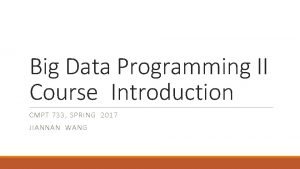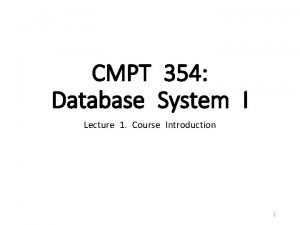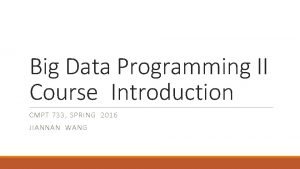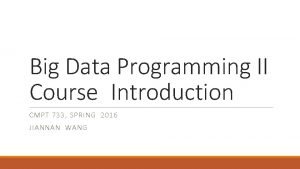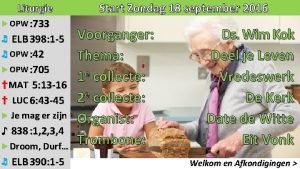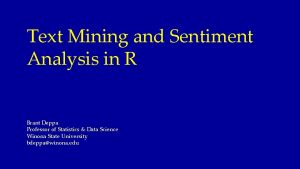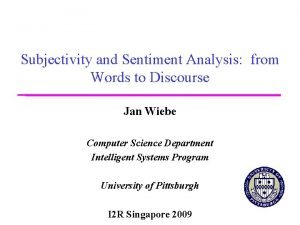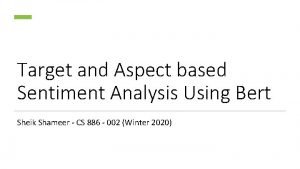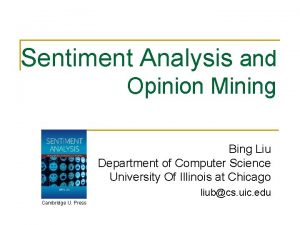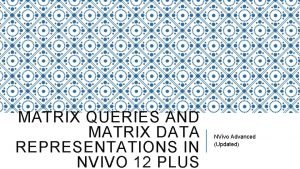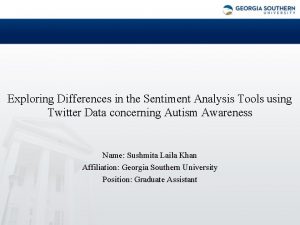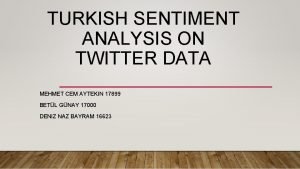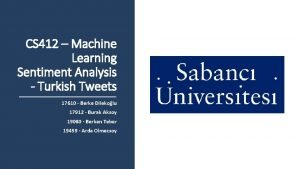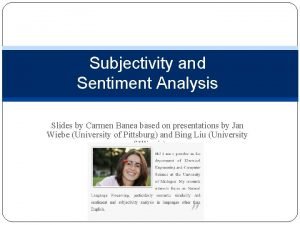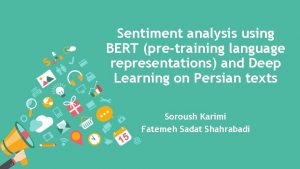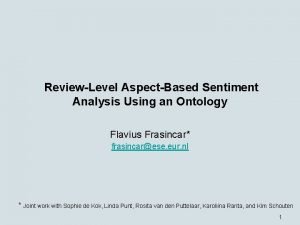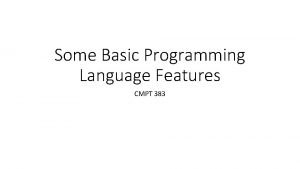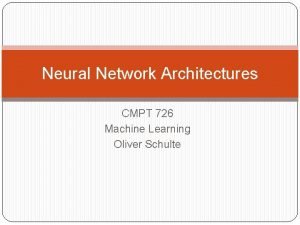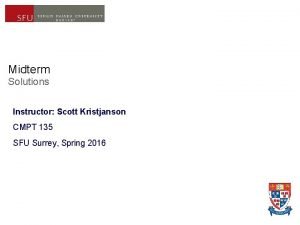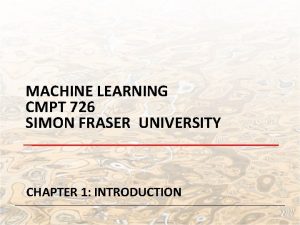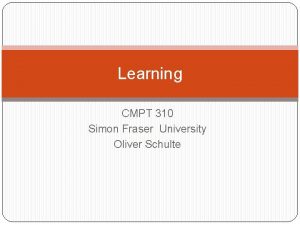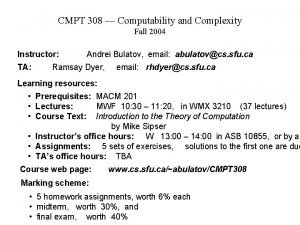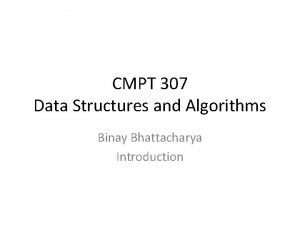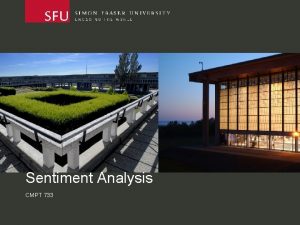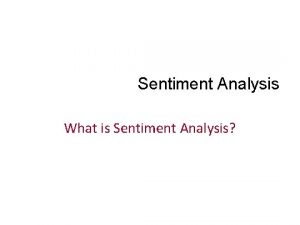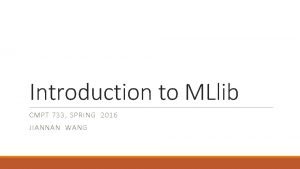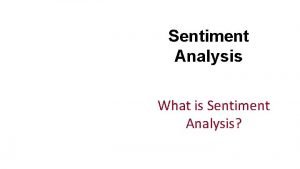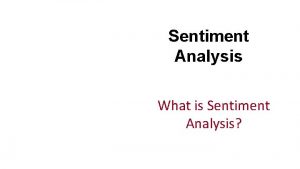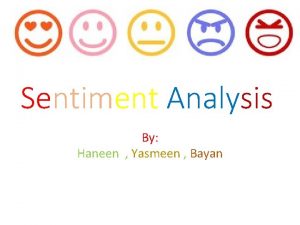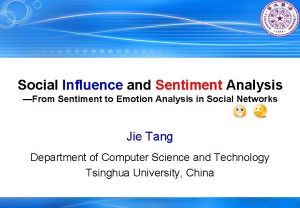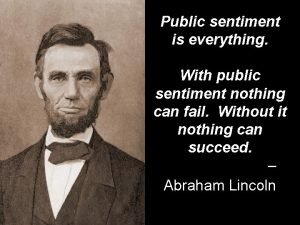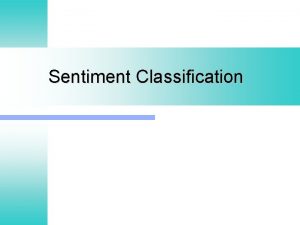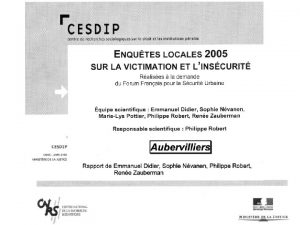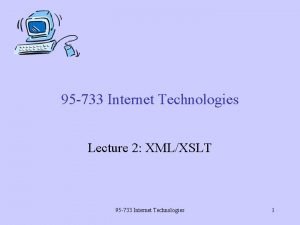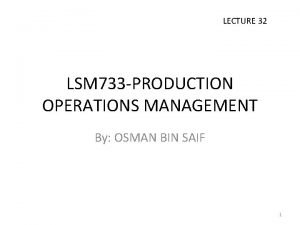Sentiment Analysis CMPT 733 What is sentiment analysis






























- Slides: 30

Sentiment Analysis CMPT 733

• What is sentiment analysis? • Overview of approach • Feature Representation • Term Frequency – Inverse Document Frequency (TF-IDF) • Word 2 Vec • Skip-gram • Model Training • • Linear Regression Assignment 2 Outline Computing Science/Apala Guha

• What is sentiment analysis? • Overview of approach • Feature Representation • Term Frequency – Inverse Document Frequency (TF-IDF) • Word 2 Vec • Skip-gram • Model Training • • Linear Regression Assignment 2 Outline Computing Science/Apala Guha

• Wikipedia: Aims to determine the attitude of a speaker or a writer with respect to some topic or the overall contextual polarity of a document. • Examples: • Full of zany characters and richly applied satire, and some great plot twists: is this a positive or negative review? • Public opinion on the stock market mined from Tweets • What do people think about a political candidate or issue? • Can we predict election outcomes or market performance from sentiment analysis? What is sentiment analysis? Computing Science/Apala Guha

• What is sentiment analysis? • Overview of approach • Feature Representation • Term Frequency – Inverse Document Frequency (TF-IDF) • Word 2 Vec • Skip-gram • Model Training • • Linear Regression Assignment 2 Outline Computing Science/Apala Guha

• Running Example: Sentiment analysis in Amazon Reviews • Amazon reviews consist of both a text and a rating • We learn the relationship between the text content and the rating Overview of Approach Computing Science/Apala Guha

Review Text I purchased one of these feom Walmart ……. Feature Extraction Feature / Representation Score Linear Regression [1 - 5] Overview of Approach Computing Science/Apala Guha

• What is sentiment analysis? • Overview of approach • Feature Representation • Term Frequency – Inverse Document Frequency (TF-IDF) • Word 2 Vec • Skip-gram • Model Training • • Linear Regression Assignment 2 Outline Computing Science/Apala Guha

• Term Frequency (TF): the number of times each word appears in a review • Review: My small cat loves this carrier. It is very soft inside and it has a small window that my cat can use to look outside. • What are the potential problems with this representation? TF-IDF Computing Science/Apala Guha

• Raw term frequency will give too much weight to terms used in long reviews • We should give equal importance to each review • Some words are ubiquitous but without significant meaning • These words will receive unnecessary importance • Usually common words occur 1 -2 orders of magnitude more times than uncommon words • We need to suppress less significant, ubiquitous words while enhancing more significant, rare words TF-IDF Computing Science/Apala Guha

• tf (term, review) = term. Freq. In. Doc (term) / total. Terms. In. Review (review) • How does this solve the problem of variable-length reviews? • idf (term) = log ((total. Reviews + 1) / (term. Freq. In. Corpus (term) + 1)) • How does this solve the problem of ubiquitous versus rare words? • tf-idf (term, review) = tf (term, review) * idf (review) • How does this overall reflect the importance of a particular term in a particular review? TF-IDF Computing Science/Apala Guha

TF-IDF Computing Science/Apala Guha

Can you spot any problems with the TF-IDF representation? TF-IDF Computing Science/Apala Guha

• Pays no attention to word semantics • Words with similar meanings are considered separately • Words having different meanings in different contexts are considered to be the same • It would be nice to incorporate some word semantics information into the feature representation TF-IDF Computing Science/Apala Guha

• What is sentiment analysis? • Overview of approach • Feature Representation • Term Frequency – Inverse Document Frequency (TF-IDF) • Word 2 Vec • Skip-gram • Model Training • • Linear Regression Assignment 2 Outline Computing Science/Apala Guha

• Word semantics are based on their context i. e. nearby words. • Example: • I love having cereal in morning for breakfast. • My breakfast is usually jam with butter. • The best part of my day is morning’s fresh coffee with a hot breakfast. • ‘cereal’, ‘jam’, ‘butter’, and ‘coffee’ are related. • We need to represent each word such that similar words have similar representation. Word 2 Vec Computing Science/Apala Guha

• Insurgents killed in ongoing fighting. • Bi-grams = {insurgents killed, killed in, in ongoing, ongoing fighting} • 2 -skip-bi-grams = {insurgents killed, insurgents in, insurgents ongoing, killed in, killed ongoing, killed fighting, in ongoing, in fighting, ongoing fighting} • Tri-grams = {insurgents killed in, killed in ongoing, in ongoing fighting} • 2 -skip-tri-grams = {insurgents killed in, insurgents killed ongoing, insurgents killed fighting, insurgents in ongoing, insurgents in fighting, insurgents ongoing fighting, killed in ongoing, killed in fighting, killed ongoing fighting, in ongoing fighting}. Word 2 Vec: Skip-gram Computing Science/Apala Guha

• Neural network trained on context of each word. • Predicts the context given a word. • The predicted context is used as the feature representation of a particular word in a review. • We need to combine the feature vectors of the words in a review to get the overall feature vector of the review. Word 2 Vec: skip-gram Computing Science/Apala Guha

I 1 x. V Nx. V 1 x. N Nx. V Vx. N Nx. V 1 x. V cereal love 1 x. V Nx. V 1 x. V for morning Word 2 Vec: skip-gram Computing Science/Apala Guha V= #distinct words

• Input layer selects a single word among V words • Output layer gives C (size of context) vectors, each of which selects one word among V words • A weight matrix W of dimension Vx. N, transforms input vector into a 1 x. N vector • • N can be informally thought of as the number of characteristics of a word • The value at each position reflects how strongly a particular characteristic is present. A weight matrix W’ of dimension Nx. V is associated with each output word vector to transform the projection layer into the output layer. • We are seeing which output word at a particular skip position matches best the features of the input word. Word 2 Vec: skip-gram Computing Science/Apala Guha

• Unsupervised learning • Semantic representation • ‘cat’ will be close to ‘kitten’ Word 2 Vec: skip-gram Computing Science/Apala Guha

Suggest some ways to combine feature vectors of the words appearing in a review to get the overall feature vector of the review. Word 2 Vec: skip-gram Computing Science/Apala Guha

My + cat + loves + this + Carrier + Average review r: Word 2 Vec: skip-gram Computing Science/Apala Guha

1 0 0 . dog x. puppy. doggy. pup . cat . petx. kitten . kitty. love . like x. favor 0 0 0 1 Word 2 Vec: skip-gram Computing Science/Apala Guha . happy. fulfilled x. satisfied 0 0 1 0

Words: + Word 2 Vec My cat loves this Carrier 1 Use cluster 0 representation 0 1 0 0 0 0 1 + + Word 2 Vec: skip-gram Computing Science/Apala Guha Average

• We need to represent an overall review with a feature vector, not just individual words • We could average the feature vectors of the individual words in the review • Or we could cluster words in the corpus, and use the degree of presence of different clusters in a review as the feature vector Word 2 Vec: skip-gram Computing Science/Apala Guha

• What is sentiment analysis? • Overview of approach • Feature Representation • Term Frequency – Inverse Document Frequency (TF-IDF) • Word 2 Vec • Skip-gram • Model Training • • Linear Regression Assignment 2 Outline Computing Science/Apala Guha

• Find the relationship between review feature vectors and rating scores • Train a linear regression model • Use the model to predict the rating of a test review • Broader classification such as positive/negative is also possible by using a threshold on the score rating Model Training Computing Science/Apala Guha

• What is sentiment analysis? • Overview of approach • Feature Representation • Term Frequency – Inverse Document Frequency (TF-IDF) • Word 2 Vec • Skip-gram • Model Training • • Linear Regression Assignment 2 Outline Computing Science/Apala Guha

• TF-IDF representation • Train Linear Regression model • Train Word 2 Vec representation • Extract average Word 2 Vec for each review • Cluster Word 2 Vec features Assignment 2 Computing Science/Apala Guha
 Cmpt 733
Cmpt 733 Cmpt 354 sfu
Cmpt 354 sfu Cmpt 733
Cmpt 733 Cmpt 733
Cmpt 733 Joint sentiment topic model for sentiment analysis
Joint sentiment topic model for sentiment analysis 02-733-2809
02-733-2809 Opw 733
Opw 733 Loof de heer o mijn ziel
Loof de heer o mijn ziel Sentiment analysis (with spark)
Sentiment analysis (with spark) Text mining and sentiment analysis in r
Text mining and sentiment analysis in r Subjectivity in sentiment analysis
Subjectivity in sentiment analysis Sentihood
Sentihood Sentiment analysis and opinion mining bing liu
Sentiment analysis and opinion mining bing liu What is nvivo used for
What is nvivo used for Sentiment analysis tools comparison
Sentiment analysis tools comparison Moontae lee
Moontae lee Sentiment analysis for hotel reviews
Sentiment analysis for hotel reviews Turkish sentiment analysis
Turkish sentiment analysis Turkish sentiment analysis
Turkish sentiment analysis Azure twitter sentiment analysis
Azure twitter sentiment analysis Slide to doc.com
Slide to doc.com ü
ü Sentiment analysis conclusion
Sentiment analysis conclusion Github liviu cotfas
Github liviu cotfas Cmpt383
Cmpt383 Cmpt 726
Cmpt 726 Cmpt 135 sfu
Cmpt 135 sfu Cmpt 726
Cmpt 726 Sfu cmpt 310
Sfu cmpt 310 Cmpt 308
Cmpt 308 Cmpt 307
Cmpt 307
